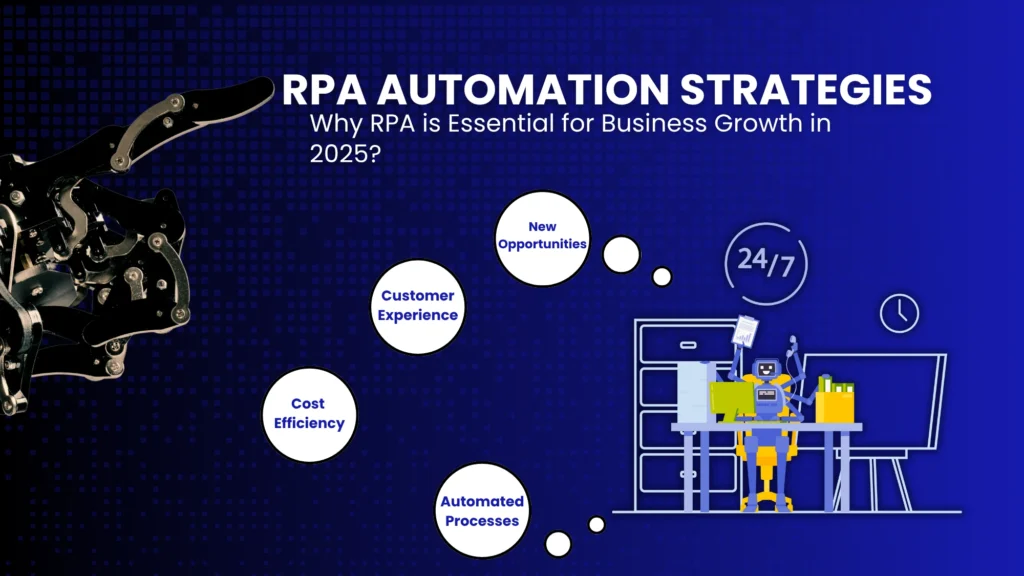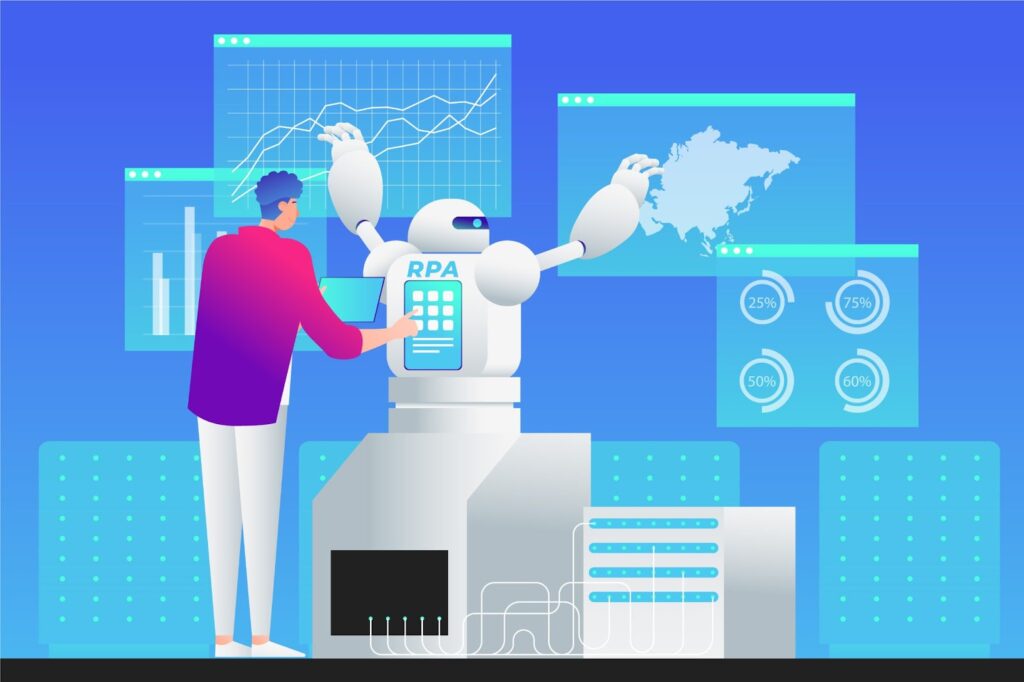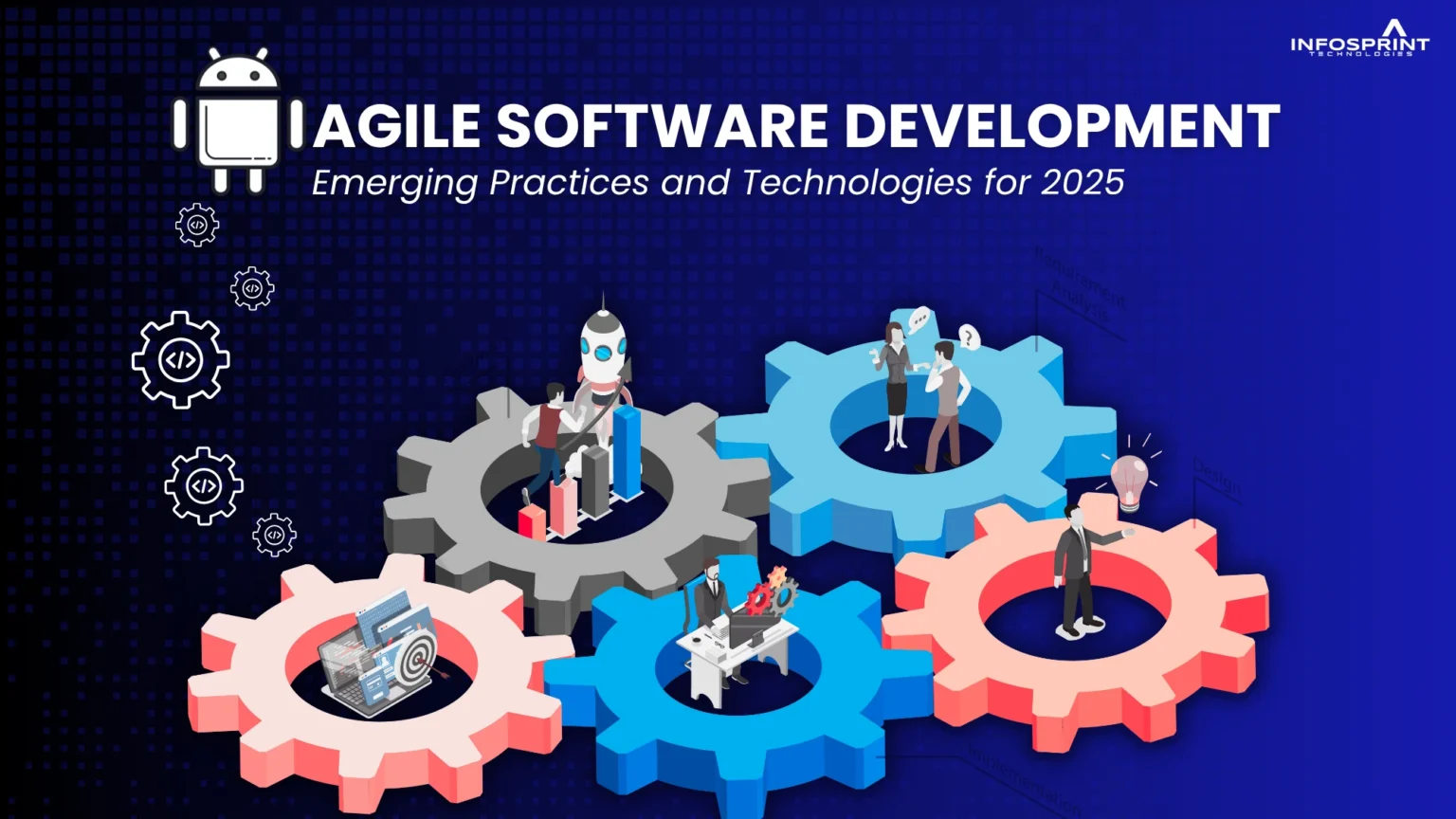RPA automation strategies: Why RPA is essential for business growth in 2025

The world strives for digital transformation, with increased new technology to assist them with the process. Robotics plays a vital role in their transformation by enabling companies to streamline workflows, reduce human error, and achieve cost-effective operations. This blog focuses on robotics process automation and how businesses can scale themselves with this technology.
What is Robotics process automation (RPA)?
RPA means the use of bots to automate repetitive tasks. RPA’s automation anywhere services make this possible. The possibility of removing human error enables companies to streamline their businesses and allows employees to focus on value-added activities. RPA automation of tasks includes data entry, processing transactions, managing inquiries, and integrating multiple systems.
By 2025, the robotics market is said to reach 20 billion dollars. Adopting this technology will not only become a tool to eliminate mundane tasks but will also be used to enhance user experience. Companies adopting this technology will reduce costs and increase effectiveness and efficiency, driving the company’s growth. According to a recent survey, 84% of Indian organizations will achieve an enterprise-wide RPA deployment or scale up existing RPA initiatives by 2025.

The Growing demand for RPA automation services
Automation became necessary for companies to become agile. The demand is driven by the need to analyze big data, external pressure from competitors, and meeting deadlines. Automation enables your business to:
- Boost Productivity: RPA can work around the clock without needing rest or breaks, increasing throughput and enabling companies to do more tasks in less time.
- Minimize Human Error: Automated systems guarantee that procedures are followed precisely and consistently, eliminating the possibility of human error that can result in expensive blunders.
- Boost Compliance: RPA helps organizations lower non-compliance risk by ensuring that tasks are carried out strictly by rules and guidelines.
- Reduce Operational Expenses: Automating repetitive work can help businesses reinvest savings into growth areas by cutting labor expenses and operational inefficiencies by a large margin.
With the growing demand for RPA automation, simply adopting the technology isn’t enough. One must scale automation strategically to remain competitive in 2025 and beyond.
Why You Need to Scale Up Your Business

Scaling is a vital factor that the company must consider for the organization’s growth. Scaling involves expanding the company without compromising efficiency while meeting the demand requirements. In today’s world, scaling is essential for development and survival. Here’s why scaling is necessary for your business:
- Customer experience: As the business grows, the number of customers also increases, making it challenging to meet customer demands. Scaling allows companies to manage customer experience by providing faster responses, analyzing customers’ data, and predicting customer demands, which is essential to improving customer satisfaction and gaining a competitive advantage.
- Seizing new market opportunities: A company that scales effectively gains a strategic advantage when entering new markets or releasing new products or services.
- Reducing operational bottlenecks: Manual procedures may develop bottlenecks as a company grows, restricting efficiency and growth. Automation—primarily through RPA—is essential to increasing because it lessens the need for human labor for repetitive operations, enabling companies to expand without interruption.
- Preserving Cost-Efficiency: Growing only sometimes entails spending more money. Businesses can grow without adding staff or resources in proportion by utilizing automation techniques like RPA. This guarantees profitability and sustainability in the long run.
- Competing in the digital economy: Businesses that don’t adapt to the rapid advancement of technology risk slipping behind their rivals. Expanding corporate activities, mainly via automation, enables businesses to maintain flexibility and effortlessly adjust to evolving market circumstances.
By integrating RPA into the scaling process, businesses can accomplish these objectives while controlling operating expenses and enhancing customer experiences. Companies may automate processes and meet rising demand using RPA’s scalable solution, eliminating the need for significant increases in human resources.
Level Up Your RPA Game in 2025: Top 5 RPA Scaling Strategies
Scaling without a strategy and effectively managing resources will help the organization to strive from the path that it is taking. Here are some of the essential tactics for growing automation:
- High-Impact Areas First: Companies that want to scale up should start by concentrating on the areas where automation will have the most significant effects. These are frequently labor-intensive, highly repetitious, and error-prone operations. Examples include customer service (answering questions), IT assistance (resetting passwords), and finance and accounting (processing payroll, for example). By initially automating high-impact areas, businesses may achieve rapid wins, gain traction, and show stakeholders the value of RPA.
- Invest in the right technology: Selecting an appropriate RPA platform is essential for growth. Businesses should search for RPA solutions that provide flexibility, scalability, and interoperability with current systems. Platforms for RPA hosted in the cloud are beneficial since they offer the scalability and flexibility required to accommodate extensive automation projects.
- Furthermore, companies should consider combining RPA with other cutting-edge technologies like machine learning (ML) and artificial intelligence (AI). This combination—often called intelligent automation—allows bots to perform more complicated activities, like data processing and decision-making, which can further improve RPA’s capabilities.
- Build an automation center: A specialized group called an Automation Center of Excellence (CoE) manages RPA initiatives, directs continuous development, and supervises the organization’s automation strategy. The CoE can serve as a focal point for RPA expertise, help standardize procedures, and guarantee that best practices are followed.
- Additionally, the CoE is essential in establishing an automation culture, aligning automation initiatives with corporate objectives, and guaranteeing the successful scaling of RPA projects.
- Employee Upskilling and Reskilling: When repetitive jobs are automated, workers may concentrate on higher-value duties like creativity, problem-solving, and client interaction. To ensure they can succeed in an automated environment, the personnel must be retrained and upskilled in light of this change.
- Employers ought to fund training initiatives that educate staff members on collaborating with robots, using RPA automation technologies, and taking on new responsibilities requiring a higher degree of creativity and critical thinking.
- Establish governance protocols: Scaling RPA requires effective governance. Businesses should establish clear procedures for bot administration and instructions for bot deployment, upkeep, and performance tracking. In addition, security needs to be given high attention, with safeguards in place to secure private information and guarantee adherence to industry rules.
- By establishing a governance framework, organizations can ensure that automation is safe, scalable, and in accordance with goals.
- RPA service provider: Partner with a company like Infosprint Technologies, a leading digital transformation company, to Leverage the expertise of industrial professionals to get consultation on RPA services.
- Utilize their insights into RPA to identify suitable automation modules, understand new technologies, and gain a competitive advantage by knowing the RPA trends.
Headwinds Ahead: Scaling RPA in a Complex World
Scaling without strategy does more harm than good. Creating an approach suitable for your company is quite challenging. Here are some headwinds you may face when scaling RPA.

- Process selection: Not all automation processes are suitable for companies’ modules, so selecting and prioritizing the appropriate automation module is a hurdle. All companies must make the process selection. While RPA might suit rule-based and repetitive tasks, not all businesses share the same structure.
- For example, RPA is not suitable for companies that rely on human judgment to generate invoices; customer responses are ideal for scaling RPA.
- Technical complexity: Integrating with current IT systems is a common step in scaling RPA, and it can be difficult and time-consuming. Implementing RPA at scale can be challenging due to incompatible data formats, diverse applications, and legacy systems.
- Organizations must address data security and compliance concerns and ensure robots can safely and seamlessly interface with various systems. Investing in a robust IT infrastructure and qualified technical personnel is necessary.
- Organization change management: RPA has the potential to drastically alter the workplace, especially for workers whose jobs could be affected by automation. Organizations must address concerns about job displacement and be ready for possible opposition to change.
- Sufficient change management is necessary to guarantee that workers support automation efforts. This entails openly discussing the advantages of RPA, offering chances for training and reskilling, and emphasizing how automation can enhance human labor rather than replace it.
- Governance and maintenance: The importance of governance increases with the scale of RPA initiatives. Oversight is necessary to manage several bots, ensure they perform as planned, and uphold security procedures. Without adequate oversight, businesses could experience bot failures, inefficiencies, or security flaws.
- In addition, bots need constant upkeep to continue working correctly. Changes in IT systems or business processes can disrupt automated workflows, so businesses must ensure that bots are updated frequently to stay up to speed with changing procedures.
Staying competitive on the edge of automation
RPA is a strategic enabler that will reshape corporate operations in the future, not just a technical instrument. Businesses that have effectively scaled automation will be better positioned by 2025 to cut expenses, enhance customer satisfaction, and maintain competitiveness in an increasingly digital marketplace.
However, increasing RPA requires thorough preparation, financial support for technology, and a human-centered approach. In the era of robotic process automation (RPA), companies that embrace automation, make the appropriate technological investments, and cultivate a continuous improvement culture will prosper.
The question still stands: Will you fall behind in the race to digital transformation, or are you scaling automation to stay competitive as the speed of change quickens? Acting now is imperative, and RPA holds the key to unleashing your company’s full potential in future years.
Related Posts

The Future of Agile Software Development Emerging Practices and Technologies for 2025

2024 Most Influenced Software Development Technologies: A Detailed Recap




